
Badrinath Temple Tour: A Spiritual Journey in Uttarakhand
The Badrinath Temple tour is a profound spiritual journey nestled in the majestic Himalayas of Uttarakhand. Dedicated to Lord Vishnu, this sacred temple is part of the revered Char Dham pilgrimage and attracts thousands of devotees each year. With its rich history dating back to ancient times, the temple offers not only spiritual solace but also stunning architectural beauty.
Visitors embark on an adventure through picturesque landscapes, culminating in the breathtaking views surrounding the temple. The journey often begins in Rishikesh, leading through scenic mountain roads to Badrinath, where the temple stands at an altitude of 3,133 meters.
The temple’s intricate architecture and the serene atmosphere create an uplifting experience. Rituals like the Aarti and the holy dip in the nearby Tapt Kund enhance the spiritual essence of the visit.
For those seeking a deep connection with divinity, the Badrinath Temple tour offers an unforgettable experience, blending faith, culture, and natural beauty. Whether for pilgrimage or exploration, this journey promises to leave a lasting impression on every visitor.

Historical Significance of Badrinath Temple
The Badrinath Temple has a rich history that dates back to ancient times. According to Hindu mythology, it is believed that the temple was established by the sage Adi Shankaracharya in the 8th century AD. The temple is situated at an altitude of 3,133 meters (10,279 feet) and is surrounded by stunning peaks, making the Badrinath Temple tour not just a spiritual journey, but also a visual feast.
The significance of Badrinath is deeply rooted in its connection to the Puranas. The temple is mentioned in several ancient texts, highlighting its importance as a sacred site. Devotees believe that visiting the temple and offering prayers can lead to salvation and the cleansing of sins.
Historical Significance of Badrinath Temple
The Badrinath Temple, situated in the heart of Uttarakhand, holds profound historical and spiritual significance for millions of devotees. As one of the four sites in the Char Dham pilgrimage, it is revered not only for its spiritual importance but also for its rich historical context.

Ancient Roots
The temple’s origins can be traced back to ancient scriptures, particularly the Puranas, which narrate the legends associated with Lord Vishnu. It is believed that this sacred site has been a place of worship for centuries, if not millennia. According to local legends, Lord Vishnu meditated here, and the region was once covered in wild berries, giving rise to the name “Badrinath,” where “Badri” means berry.
Sage Adi Shankaracharya
The temple’s historical significance was notably amplified in the 8th century when Adi Shankaracharya, a revered philosopher and theologian, established the temple in its current form. He played a crucial role in reviving Hinduism and promoting the worship of Lord Vishnu at this site. Shankaracharya’s influence helped solidify Badrinath’s status as a major pilgrimage destination.
Architectural Heritage
The architecture of the Badrinath Temple reflects traditional Hindu design, with intricate carvings and beautiful murals depicting various deities. The temple’s sanctum houses the black stone idol of Lord Vishnu in a meditative posture, symbolizing peace and tranquility. This architectural marvel has stood the test of time, bearing witness to centuries of devotion.
Cultural Significance
Over the years, the Badrinath Temple has become a melting pot of cultural and religious traditions. Pilgrims from different regions of India and beyond visit the temple, contributing to its diverse cultural tapestry. Festivals celebrated here, such as Badri Kedar Utsav and Janmashtami, attract large gatherings, showcasing the rich heritage associated with this sacred site.

The Journey to Badrinath Temple
Embarking on the journey to the Badrinath Temple is as enriching as the spiritual experience itself. Nestled in the Himalayas at an altitude of 3,133 meters (10,279 feet), this sacred destination requires careful planning and a sense of adventure. Here’s an overview of how to reach this revered site.
Starting Point: Rishikesh
Most pilgrims begin their journey in Rishikesh, a vibrant town known as the “Yoga Capital of the World.” Rishikesh serves as the gateway to the Char Dham pilgrimage, including Badrinath. Here, you can find accommodations, eateries, and local transportation options.
Transportation Options
- By Road:
- Private Taxi: Hiring a taxi is a popular and convenient option. The drive from Rishikesh to Badrinath covers about 300 kilometers and takes around 10-12 hours, depending on road conditions. The scenic route includes winding mountain roads and breathtaking views of rivers and valleys.
- Buses: State-run and private buses operate regularly between Rishikesh and Badrinath. While this is a cost-effective option, the journey may take longer due to multiple stops.
- By Air:
- The nearest airport is Jolly Grant Airport in Dehradun, approximately 310 kilometers from Badrinath. From the airport, you can hire a taxi or take a bus to reach your destination. This option is suitable for those looking to save time.
- By Train:
- The closest railway station is in Rishikesh. Trains connect Rishikesh to major cities in India, making it a convenient starting point for your pilgrimage.
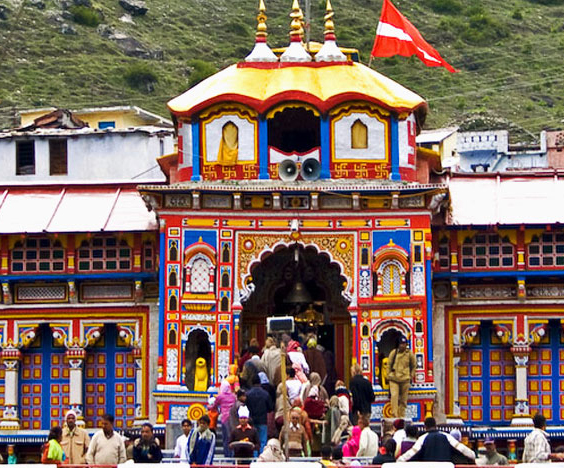
The Scenic Route
The drive to Badrinath is nothing short of spectacular. As you ascend the mountains, the landscape transitions from lush greenery to rocky terrains. The route follows the Alaknanda River, offering stunning views of waterfalls, terraced fields, and quaint villages.
Essential Stops Along the Way
- Devprayag: Known for the confluence of the Bhagirathi and Alaknanda rivers, this is a picturesque spot to take a break and admire nature.
- Rudraprayag: Another confluence point where the Mandakini river meets the Alaknanda. The region is steeped in mythology and offers beautiful views.
Arrival in Badrinath
Upon reaching Badrinath, the temple is often the first sight to behold. The temple complex is bustling with pilgrims and the atmosphere is charged with devotion. Visitors usually begin their spiritual experience with a dip in the nearby Tapt Kund, a natural hot spring believed to have healing properties.
Best Time to Visit
The best time for a Badrinath Temple tour is between May and November. The temple usually opens for devotees on Akshaya Tritiya, which typically falls in late April or early May. During this time, the weather is pleasant, making it ideal for pilgrims. The temple closes around Diwali, usually in late October or early November.
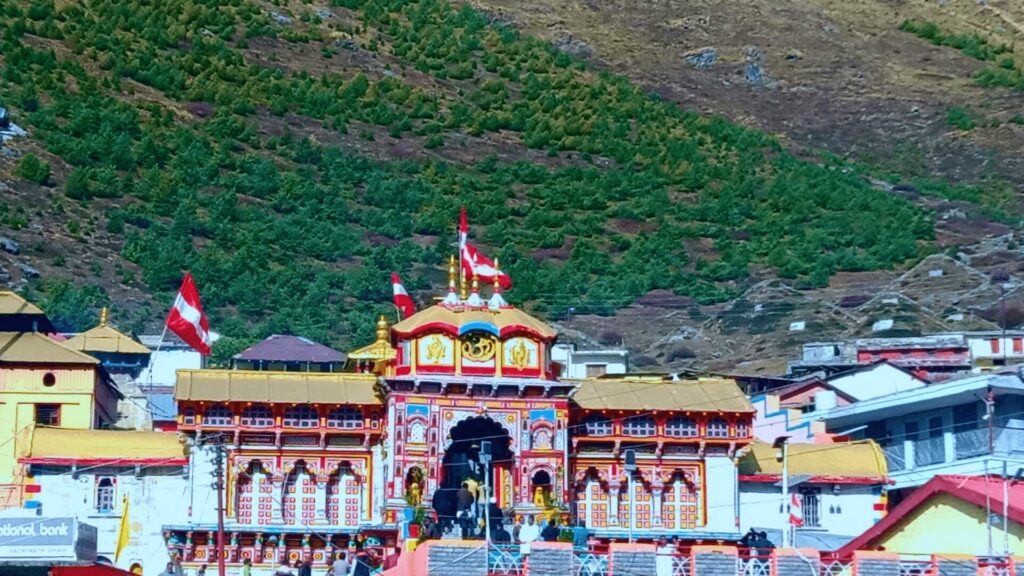
Exploring Badrinath Temple
The Badrinath Temple is not just a religious site; it’s a rich tapestry of history, culture, and spirituality nestled in the breathtaking landscape of Uttarakhand. As one of the four sacred shrines of the Char Dham pilgrimage, it draws millions of devotees and tourists alike. Here’s a guide to exploring the temple and its surroundings.
Architectural Marvel
The architecture of the Badrinath Temple is a stunning representation of traditional Hindu design. The temple features:
- Singh Dwar (Lion’s Gate): The grand entrance is adorned with intricate carvings and vibrant murals depicting various deities, welcoming devotees into a sacred space.
- Sanctum Sanctorum: Inside, the main idol of Lord Vishnu is enshrined in a black stone, depicted in a meditative posture. The sanctum exudes an aura of tranquility and devotion.
- Artistic Details: The walls and ceilings are decorated with beautiful paintings and sculptures, illustrating stories from Hindu mythology.
Spiritual Atmosphere
The moment you enter the temple complex, you are enveloped in a serene atmosphere filled with the sound of chanting, ringing bells, and the aroma of incense. Participate in the Aarti, a ceremonial worship with light, held twice daily. This experience is deeply moving and enhances the spiritual ambiance.
Important Rituals
- Tapt Kund: Before entering the temple, many pilgrims take a holy dip in the nearby Tapt Kund, a natural hot spring believed to purify the soul and cleanse sins.
- Puja and Offerings: Visitors can offer prayers and perform rituals inside the temple, connecting deeply with their spirituality. Engaging in these rituals allows you to be part of the rich religious culture.
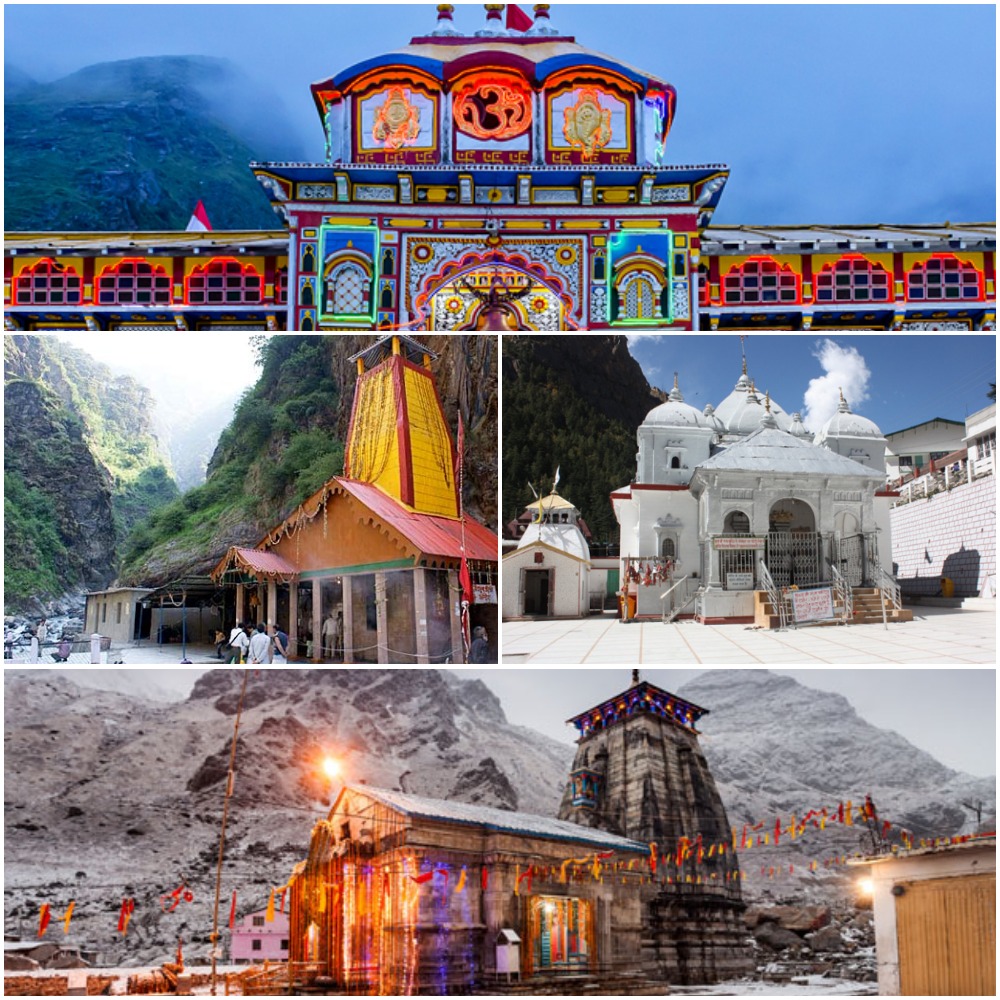
Surrounding Attractions
While the Badrinath Temple is the main draw, the surrounding area also offers various points of interest:
- Mana Village: Located just a few kilometers from the temple, this quaint village is the last inhabited village before the Indo-Tibetan border. Explore its traditional homes and interact with the local community.
- Charanpaduka: This sacred site, believed to hold the footprints of Lord Vishnu, is a short trek from Badrinath. It provides stunning views and a peaceful environment for meditation.
- Vyasa Gufa: Visit the cave where sage Vyasa is said to have composed the Mahabharata. This site is steeped in legend and offers a unique insight into ancient Hindu traditions.
Practical Tips for Visitors
- Dress Modestly: As a sacred site, it’s essential to dress appropriately. Ensure your attire is respectful, covering shoulders and knees.
- Stay Hydrated: The high altitude can lead to dehydration, so carry water and stay hydrated during your visit.
- Be Mindful of Weather: The weather can be unpredictable; layering your clothing is advisable to adapt to changing conditions.
Architectural Marvel
The Badrinath Temple is an architectural masterpiece. Its striking entrance, known as the “Singh Dwar,” features intricate carvings and a beautiful façade. The temple is built in the style of traditional Hindu architecture and is adorned with colorful murals and sculptures depicting various deities.
Inside the temple, the main idol of Lord Vishnu is enshrined in a sanctum, which is made of black stone and is about one meter tall. The idol is depicted in a meditative posture, adorned with gold and precious stones. The atmosphere inside the temple is spiritually uplifting, filled with the chants of devotees and the aroma of incense.
Rituals and Festivals
Participating in the rituals during your Badrinath Temple tour adds depth to your experience. Daily rituals, known as “puja,” are performed by priests, and devotees can witness these ceremonies. Major festivals like Badri Kedar Utsav and Janmashtami attract large crowds, making the temple vibrant with celebrations.
Visitors are encouraged to partake in the Aarti (a ceremonial worship with light) that takes place twice daily. This experience is profoundly moving and is a highlight of the Badrinath Temple tour.
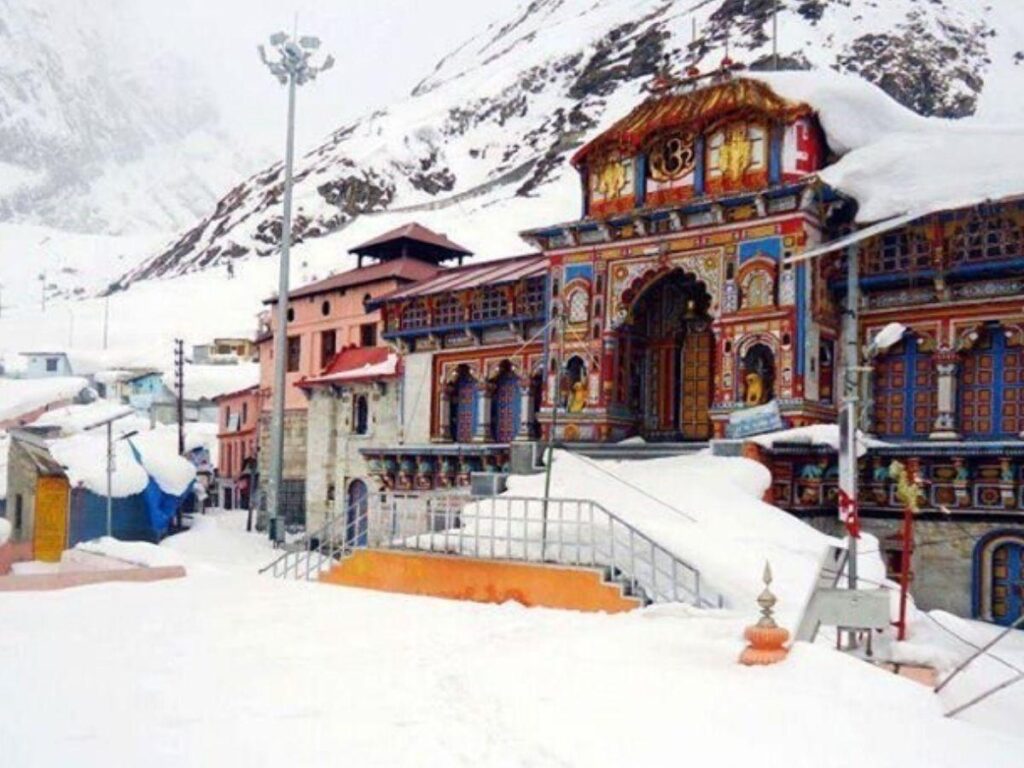
Surrounding Attractions
Tapt Kund
Tapt Kund is a revered site located near the Badrinath Temple in Uttarakhand, known for its natural hot springs and significant spiritual importance. This sacred site plays a crucial role in the pilgrimage experience for countless devotees who journey to Badrinath each year.
As pilgrims approach Tapt Kund, they are often struck by the serene atmosphere and stunning backdrop of the majestic Himalayas. The hot springs here are believed to possess healing properties, and many visitors partake in the tradition of taking a holy dip before entering the temple. This act is seen as a form of purification, washing away sins and preparing the soul for the divine experience that awaits at the Badrinath Temple.
The water in Tapt Kund is heated naturally by geothermal activity, with temperatures reaching comforting levels. The warm, mineral-rich waters provide not only physical relief from the cold climate but also a sense of spiritual rejuvenation. Surrounded by the beauty of the mountains and the soothing sounds of nature, Tapt Kund offers a moment of tranquility amidst the hustle and bustle of pilgrimage.
Engaging in rituals at Tapt Kund deepens the spiritual experience. Devotees often express gratitude and seek blessings here, making offerings as they immerse themselves in the warm waters. This connection to tradition and the divine enhances the overall significance of the visit.
Accessible by a short walk from the Badrinath Temple, Tapt Kund is a convenient stop for pilgrims. Its proximity allows visitors to seamlessly incorporate it into their spiritual journey. The site not only enriches the pilgrimage but also serves as a reminder of the natural beauty and sacredness that permeate the region.
In essence, Tapt Kund is much more than just a hot spring; it is a sanctuary for purification and reflection, offering a unique blend of natural beauty and spiritual depth. For anyone undertaking the Badrinath Temple tour, a visit to Tapt Kund is an essential part of the experience, providing both physical warmth and spiritual solace in this enchanting corner of the Himalayas.
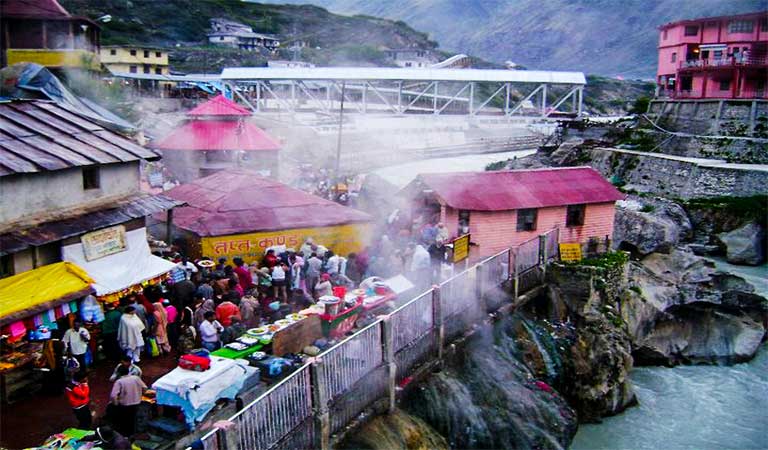
Mana Village
Nestled just a few kilometers from the Badrinath Temple, Mana Village is a captivating destination that embodies the essence of Himalayan culture and tradition. Often recognized as the last inhabited village before the Indo-Tibetan border, it offers a unique glimpse into the lives of the local Garhwali people.
The village is steeped in history and mythology, with strong ties to the epic Mahabharata. According to local legend, the sage Vyasa composed this monumental text in a cave known as Vyasa Gufa, situated nearby. This connection adds a layer of significance to Mana, making it a meaningful stop for both pilgrims and those interested in the region’s rich cultural heritage.
Walking through the village, visitors are treated to charming wooden houses adorned with intricate carvings and slate roofs, reflecting traditional Himalayan architecture. The warm hospitality of the villagers enhances the experience, allowing travelers to witness daily life, which revolves around agriculture and local crafts.
Surrounded by majestic mountains, Mana offers breathtaking views that captivate the spirit. The serenity of the landscape is complemented by sites like Bhim Pul, a natural stone bridge that further connects the village to its mythological roots.
Exploring Mana is a delightful experience. A short trek from Badrinath leads you into this picturesque haven, where one can savor traditional cuisine and engage with the local community. Festivals celebrated here, such as Harela and Ganga Dussehra, showcase the vibrant traditions that enrich the cultural tapestry of the area.
In essence, Mana Village is more than a mere waypoint on the journey to Badrinath; it is a destination rich in culture, history, and natural beauty. Whether one seeks spiritual reflection or simply wishes to soak in the tranquility of the Himalayas, Mana provides a memorable experience that enhances the overall pilgrimage to the Badrinath Temple.
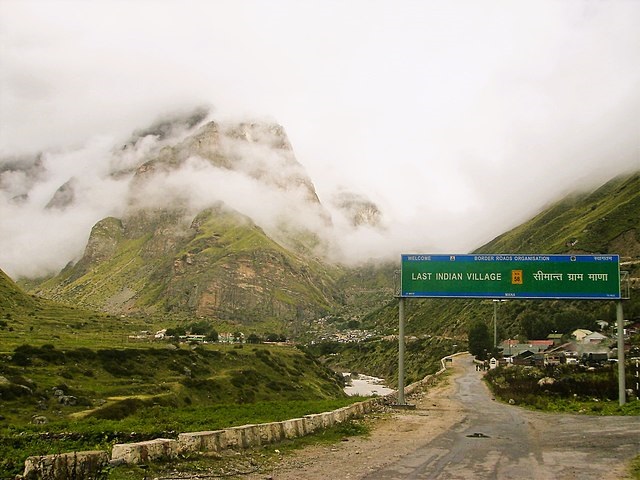
Charanpaduka
Charanpaduka, located a short trek from the Badrinath Temple, is a significant and serene site that draws pilgrims seeking both spiritual connection and natural beauty. Believed to be the place where Lord Vishnu’s footprints are preserved, Charanpaduka is imbued with deep religious significance, making it a must-visit for devotees.
The journey to Charanpaduka offers a rewarding experience, winding through picturesque landscapes dotted with vibrant flora and panoramic views of the majestic Himalayas. As visitors ascend, they are often enveloped by the tranquility of the surroundings, creating a peaceful atmosphere conducive to reflection and meditation.
The site itself features a small platform where the revered footprints are marked, serving as a focal point for prayer and devotion. Many pilgrims stop here to offer their respects, taking a moment to soak in the spiritual energy that permeates the area. The serene ambiance, combined with the breathtaking scenery, enhances the experience of those who visit.
In addition to its spiritual importance, Charanpaduka is a fantastic spot for nature enthusiasts and photographers. The rugged terrain and stunning vistas provide ample opportunities to capture the beauty of the Himalayas. Whether it’s the sight of snow-capped peaks or the sound of distant waterfalls, the area around Charanpaduka offers a feast for the senses.
For those on a Badrinath Temple tour, a visit to Charanpaduka is a rewarding extension of the spiritual journey. It invites pilgrims to connect more deeply with their faith while immersing themselves in the awe-inspiring beauty of the region. The combination of reverence, natural splendor, and tranquility makes Charanpaduka an unforgettable destination on the path to Badrinath.
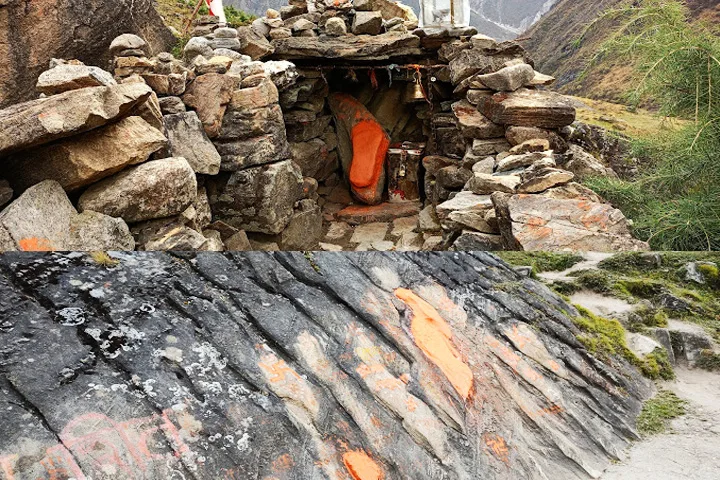
Tips for a Successful Badrinath Temple Tour
- Plan Ahead: Given its remote location, planning your Badrinath Temple tour in advance is crucial. Book accommodations and transportation early, especially during peak pilgrimage seasons.
- Dress Appropriately: The weather can be unpredictable, so wear warm clothing and comfortable shoes. Layering is recommended as temperatures can vary significantly.
- Stay Hydrated: High altitudes can lead to dehydration. Carry sufficient water and snacks during your journey to stay energized.
- Respect Local Customs: When visiting the temple, be mindful of the rituals and customs. Photography may be restricted in certain areas, so always ask for permission.
- Health Precautions: If you have any health concerns, consult with your doctor before the trip, especially if you are prone to altitude sickness.
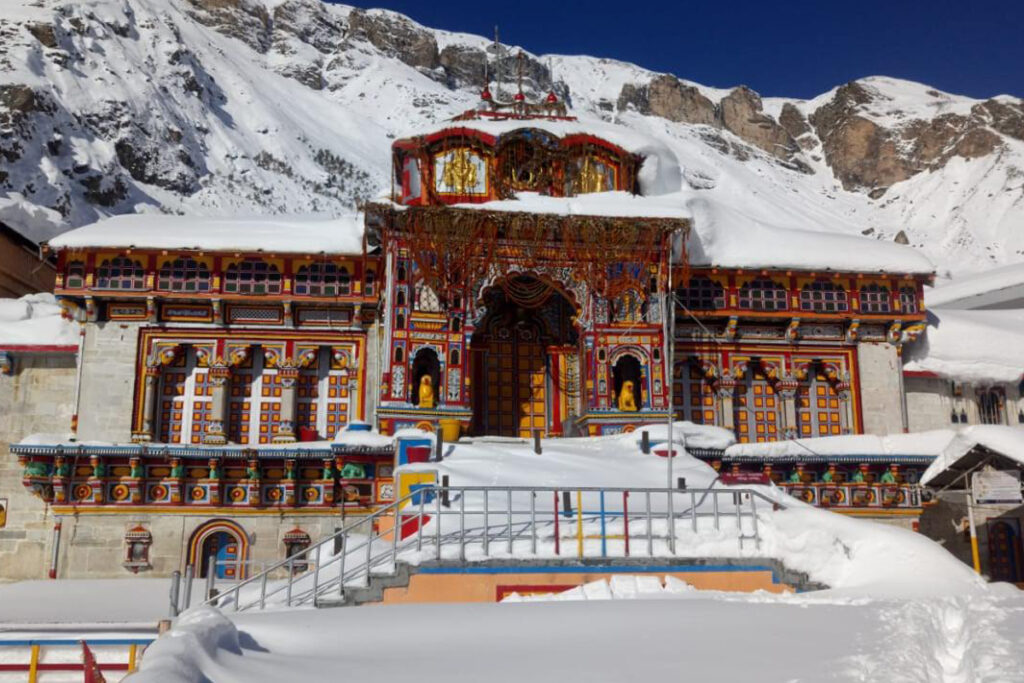
Conclusion
The Badrinath Temple tour is more than just a pilgrimage; it is a journey into the heart of spirituality, culture, and natural beauty. From the majestic architecture of the temple to the breathtaking landscapes surrounding it, every moment spent in Badrinath is a memory to cherish.
Whether you seek spiritual solace or simply wish to experience the beauty of the Himalayas, a visit to Badrinath Temple promises an enriching experience that will stay with you long after your journey ends. Embrace the divine atmosphere, partake in the rituals, and immerse yourself in the enchanting beauty of this sacred site. Your Badrinath Temple tour awaits, offering an opportunity to connect with the divine and nature in one of India’s most revered locations.








Leave a Reply